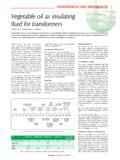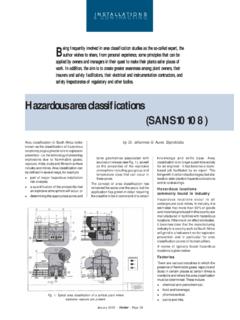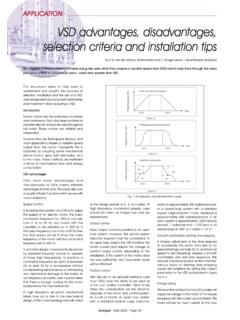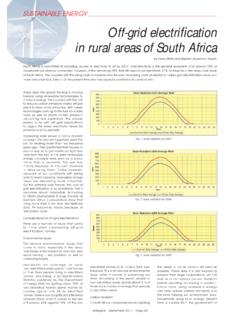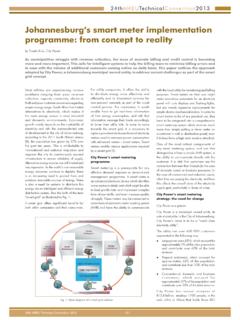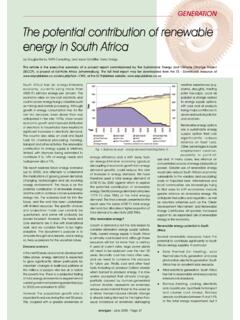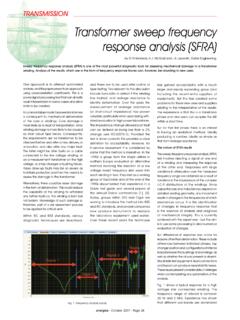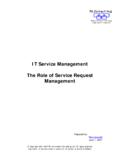Transcription of technical A closer look at project life cycles - EE …
1 GIStechnicalPositionIT - Sept/Oct 2007 37 The project Management Institute-PMI [2] simply states that, a project is a temporary endeavour undertaken to create a unique product, service, or result . A different view to a project is offered according to systems theory (see Jackson [3]). The project follows the systems view of breaking it down into phases. Each phase can possibly be further broken down into lower processes with specific objectives. A systems approach to a project allows us not only to break down the systems ( the project ) into subsystems, but provides the techniques and tools to take into account the environment which will be affected, or which will affect the system (assuming it is an open system) - hence considering inputs, outputs and constraints. Generally, after an analysis of all the literature, one would then summarise a project as a temporary effort of work that meets the following criteria: has a start date and an end date has a schedule, cost and quality constraints is a unique endeavour and contains risk has a certain scope.
2 The project life cycle A definition of life cycle is stated by Global Knowledge [4]: life cycle implies two things: that a process is perpetual and that the sequence of events is obligatory or uni-directionary . However the term life cycle is not used in its true sense in projects and systems. life cycle in this instance is neither a perpetual circle of events nor is the sequence of events rigidly fixed; otherwise this would strongly contract to the project s definition, which assumes a finite period. Generally, project life cycles have phases, which are sequential, and their ends are punctuated by either A closer look at project life cyclesby Dr. Solomon Bhunu, Corporate GIS, Cape Town What is a project ? Literature presents a plethora of project definitions. Nicholas [1] defines it as such: "a project is a system of people, equipment, materials and facilities organised and managed to achieve a goal . One has to note the absence of the temporary nature phenomenon of a project in this information transfer or technical component hand over.
3 project phases vary by project or industry, but some general phases include concept, development, implementation and support. The general trend depicted by life cycles [2], is that, cost and staffing levels are low at the start, rise during the middle phases, but subside as the project comes to an end (see Fig. 1)Comparison of different project life cycles This section provides a comparison of commonly used project life cycles . A brief description of the cycle is given first, then strengths and weaknesses are discussed and lastly a summarised view is provided. The discussions on strengths and weaknesses are based on works by Charvat [5], Business eSolutions [6] and Gardiner [7]. WaterfallThe waterfall model originated in 1970 largely through the efforts of Dr. Winston Royce [5]. The model has gone through a number of changes and revisions ever since. The model gets its name from the analogy of water falling downward (see Fig. 1: project life cycle : project cost and staffing across the life cycle (adapted from PMBOK [2]).)
4 Fig. 2: Water fall project life cycle (adapted from Charvat [5]). technicalGIS38 PositionIT - Sept/Oct 2007 Fig. 2). The number of phases varies depending on the project , but there is a clear transition from one phase to the next. The pure waterfall performs well for products with clearly understood requirements or when working with well understood technical tools, architectures and infrastructures. Its weaknesses frequently make it inadvisable when rapid development is needed. In those cases, modified models may be more effective. Incremental life cycleThe concept behind the incremental project life cycle is that of aiming to produce usable products at the end of each section. The model (see Fig. 3) uses the waterfall approach in overlapping sections. In reality, the whole cycle will be led by a series of objectives, which are assigned to each section. General objectives are defined at the beginning of the project . SpiralThe spiral is a risk-reduction oriented model that breaks a software project up into mini-projects, each addressing one or more major risks.
5 The model was developed to counter the problems of the waterfall method. It is cyclic, hence the name spiral as opposed to the linear waterfall model (see Fig. 4). The spiral model has six phases: planning, risk analysis, engineering/development and evaluation. A systems project repeatedly passes through these phases in iterations (called spirals in this model). The baseline spiral, starting in the planning phase, is Fig. 3: Incremental project life cycle (adapted from Gardiner [7]). Fig. 4: Spiral model of project life cycle (adapted from Charvat [5]).Fig. 5: Rapid application development life cycle (adapted from Gardiner [7]).where requirements are gathered and risk is assessed. Each subsequent spiral builds on the baseline are gathered during the planning phase. In the risk analysis phase, a process is undertaken to identify risk and alternate solutions. A prototype is produced at the end of the risk analysis phase. Software is produced in the engineering phase, along with testing at the end of the phase.
6 The evaluation phase allows the customer to evaluate the output of the project to date before the project continues to the next the spiral model, the angular component represents progress, and the radius of the spiral represents projects with risky elements, it is beneficial to run a series of risk-reduction iterations which can be followed by a waterfall or other non-risk-based lifecycle. Rapid application development (RAD) Sometimes users just want to see a product they can understand and not have to wait for the development to get off the build line. Traditional software development methodologies usually follow a sequence of steps with formal sign-offs normally at the end of each project phase. This process can be time consuming, but RAD shortens the approach (see Fig. 5). With RAD, each iterative development cycle delivers a functional version of the proposed solution. The approach is almost cyclic in nature. However, many organisations don't have the time to spend lengthy periods on development; they want to see immediate results.
7 By following a RAD model, clients are able to use a "building block approach" to see the results. Using RAD, results are almost immediate and the product starts becoming tangible. The developers have the advantage of building on their solution and gradually improving it until it reflects what the client requires. Compared with many traditional methodologies, RAD compresses the analysis, design, development, and test phases into a dynamic series of short iterative development cycles . RAD uses shorter project phases, which means that benefits are realised much more quickly. RAD prototyping can reduce costs. It allows the project technicalGIS40 PositionIT - Sept/Oct 2007manager and the team to identify risks early during the project life cycle . The approach overlaps project phases. However, one of the biggest concerns found with RAD is with quality assurance during the development of the project . project managers, therefore, must ensure that quality assurance is built into the project .
8 Evolutionary (also known as iterative)The evolutionary cycle also maintains a series of phases that are distinct and cascading in nature. As in the other cycles , each phase is dependent on the preceding phase before it can begin and requires a defined set of inputs from the prior phase. As Fig. 6 portrays, the evolutionary model is similar to the incremental in that during the design phase development is broken into a distinct increment or subset of requirements. However, only this limited set of requirements is constructed through to implementation. The process then repeats itself with the remaining requirements becoming an input to a new requirements phase. The left over requirements are given consideration for development along with any new functionality or changes. Another iteration of the process is accomplished through implementation with the result being an evolved form of the same software product. This cycle continues with the full functionality evolving overtime as multiple iterations are completed.
9 Agile/extremeAgile or extreme programming is just emerging as a potentially viable systems development life cycle (SDLC) methodology. The basic tenets in philosophy are consistent with other valid SDLC methodologies and the basis in processes is founded on the waterfall methodology as are other SDLC methodologies. However, rather than focusing on documenting requirements, agile/extreme seeks to compress time in the scope through design phases by utilising stories, scenarios, and use cases as replacements for formal documentation. Likewise development and test take place inside of a pre-defined time box as an additional means of time compression (see Fig. 7). The emphasis is on reaching implementation as rapidly as possible. The goal is often to reach implementation in days rather than and refactoring used to redesign or re-scope the effort. Background and description of the project Currently the Municipality of Cape Town has two main property information systems (see Fig.)
10 8).The geographical information system (GIS): This system is spatially enabled Fig. 6: Evolutionary project life cycle (adapted from PM Solutions [8]). Fig. 7: Agile or extreme programming. months or years. Additionally, as Fig. 7 depicts, multiple time boxes can be employed in an incremental fashion to achieve additional functionality. As in incremental, these can be sequential or in parallel. Likewise, evolutionary techniques are employed to achieve additional software functionality shown via the dashed lines. Development and test are iterated to generate rapid evolution of product functionality Fig. 8: Illustration of the current LIS and GIS systems interfacing with business. BillingPropertytechnicalGISP ositionIT - Sept/Oct 2007 41 it allows for graphical display of properties and showing the true spatial relationships. Land information system (LIS): This system captures the property information again but it is basically tabular based, with no ability to spatially display these properties.
